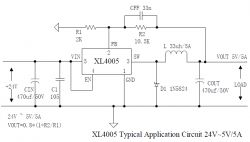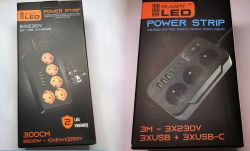BOOM i ZONK wrote: I believe that the diode (SS54) used there causes the internal MOSFET to "burn", especially in the event of its short circuit. Datasheet recommends using a diode with an average forward current of 10A and not only 5A, as in the case of SS54. Of course, I may be wrong ...
In my opinion, the most accurate reasoning.
If, as a result, both the diode and the circuit are damaged at the same time, the scenario must proceed in chronological order: the destruction of the diode, then the destruction of the circuit. The reverse scenario is impossible.
Looking at the diagram:

it is clearly visible that no internal short circuit in the XL4005 is able to endanger the diode because for the voltages on the XL4005 the diode is in the reverse direction.
Also, the saturation of the choke cannot be the reason for the destruction of the diode, because it only conducts the current coming from the energy of the magnetic field in the choke. So you can even say that saturation protects it in some way, because it limits the power of the impulse induced in the choke after turning off the key in the XL4005.
So the conclusion as to the failure rate of these modules could be made such that the diodes are inadequate to the required parameters and the failure rate of the XL4005 itself is unknown (in fact, it is difficult to require that the XL4005 itself be protected against a diode failure, because it is a catastrophic situation in itself).





